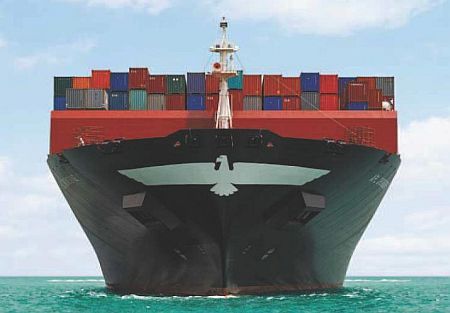
Today at the SMM Event in Hamburg DNV presented a hull design that will boost fuel economy.
A collaboration involving APL, Hyundai Heavy Industries and DNV has resulted in a hull design that will make APL’s 10 new ultra large container ships some 20 per cent more fuel efficient per TEU compared with existing designs.
The design has been optimized for an operating profile along the Far East to Europe trade route involving nine speed and draught combinations. The installed propulsive power could be reduced by about 16 per cent compared to the initial hullform optimized for one draft & speed condition.
The first of the new 13,800 TEU ships is under construction at Hyundai Heavy Industries (HHI) and will be delivered next year.
The resulting fuel savings will be worth about 3 million USD per ship per year to APL. “In the current challenging market environment it is extremely important for APL to introduce efficient and flexible container ships, which help us to reduce slot costs. These ships will be the most fuel-efficient ships ever built to the Asia-Europe container trade,” says Cedric Foo, Group Deputy President and CFO of APL’s mother company NOL. “APL has decided to advance the delivery of the newbuildings, which have been ordered in 2011 using their superior fuel efficiency to make a contribution to cutting emissions as soon as possible.”
Traditionally container ships spend much of their time operating at ‘off-design’ conditions which increase hull resistance and reduce propeller and engine efficiency. In this case, the ships will operate at speeds typically ranging from 15 to 19.5 knots but with a maximum speed of about 23 knots. With the aid of sophisticated software and virtual sea trials, the three partners were able to analyse the proposed trading pattern of the ships and optimise accordingly.
“This is a new way of cooperation between the partners in a newbuilding project,” explains Gyung-Jin Ha, Executive Vice President of the Basic Design Office in the Shipbuilding Division of HHI. “Due to a concentrated and professional effort from all three parties within their respective roles we managed not only to keep the tight design schedule, but also to unlock an amazing potential for fuel savings,”
“For design optimization an innovative methodology has been deployed. Ideas and further innovation have been made more specific based on the DNV Quantum concept launched in 2010. We are pleased to see that this is utilized by HHI and APL for real designs now,” says Tor Svensen, President DNV Maritime and Oil & Gas. “This is the way of the future. Financial and environmental performance demands more sophistication, and DNV is ready with the technology, the people and the enthusiasm to ensure that shipowners get the best results possible.”
We use cookies to improve your experience. By continuing to use our site, you accept our Cookies, Privacy Policy,Terms and Conditions. Close X